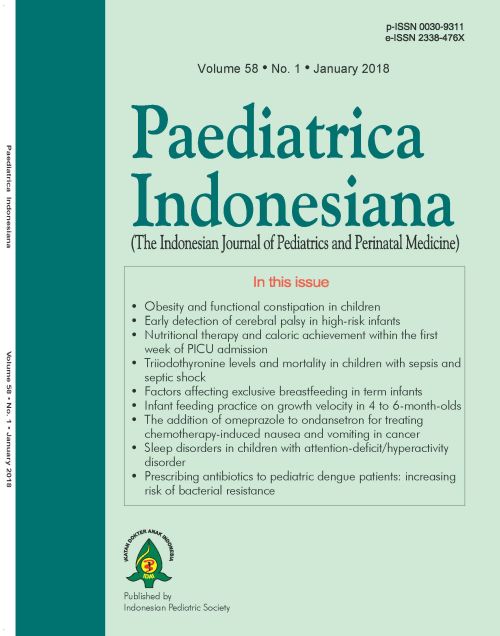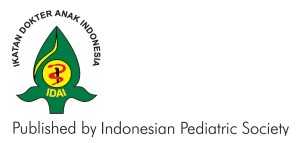Triiodothyronine levels and mortality in children with sepsis and septic shock
Abstract
Background Sepsis is the most common cause of death in infants and children. It can cause hormonal imbalances, such as euthyroid sick syndrome (ESS), which may increase the risk of death.
Objective To evaluate a possible correlation between the level of triiodothyronine (T3) and mortality in children with sepsis and septic shock.
Methods An observational cohort study was conducted on 80 children with sepsis and septic shock from October 2015 until January 2016 in Haji Adam Malik General Hospital, Medan. Subjects underwent PELOD score and T3 examination on the first day admitted in Haji Adam Malik General Hospital. Chi-square test was used to analyze for a correlation between the T3 values and mortality.Â
Results Of the 80 consecutive subjects, 39 (48.75%) had low T3 level on the first day. Of these 39 children, 36 (92.3%) died. Subjects with low T3 level had a 6.31 times higher risk of mortality(PR 6.31; 95%CI 2.99 to 13.28; P<0.001). Of the 31 subjects with high PELOD score, 23 (74.2%) had decreased T3 (PR=2.27; 95%CI 1.45 to 3.57; P<0.001).
Conclusion Low T3 level has significant relationship with mortality in children with sepsis and septic shock.
References
2. Carvalho PR, Trotta Ede A. Advances in sepsis diagnosis and treatment. J Pediatr (Rio J). 2003;79:195-204.
3. Dellinger RP, Levy MM, Rhodes A, Annane D, Gerlach H, Opal SM, et al. Surviving sepsis campaign: international guidelines for management of severe sepsis and septic shock: 2012. Crit Care Med. 2013;41:580-637.
4. Latief A, Antonius HP, Dadang HS, Enny HA, G Dharma M, et al. Diagnosis dan tatalaksana sepsis pada anak. In: Latief A, Antonius H P, Dadang HS, Enny HA, G Dharma M, et al., editors. Unit Kerja Koordinasi Pediatri Gawat Darurat Ikatan Dokter Anak Indonesia. Jakarta: Ikatan Dokter Anak Indonesia; 2010. p. 1-18.
5. Goldstein B, Giroir B, Randolph A. International Consensus Conference on Pediatric Sepsis: definitions for sepsis and organ dysfunction in pediatrics. Pediatr Crit Care Med. 2005;6:2-8.
6. Riset Kesehatan Dasar 2007. [cited 2015 August]; Available from: http:// www.riskesdas.litbang.depkes.go.id/.
7. Saraswati DD, Pudjiadi AH Djer MDMD, Supriyatno B Syarif DR, Kurniati N. Faktor risiko yang berperan pada mortalitas sepsis. Sari Pediatri. 2014;15:281-9.
8. Sianturi P, , Lubis BM, azlin E, Tjipta GD. Gambaran pola resistensi bakteri di unit perawatan neonatus. Sari Pediatri. 2012:13:431-6.
9. Chopra IJ. Clinical review 86: Euthyroid sick syndrome: is it a misnomer? J Clin Endocrinol Metab. 1997;82:329-34.
10. Angelousi GA, Karageorgopoulos DE, Kapaskelis AM, Falagas ME. Association between thyroid function tests at baseline and the outcome of patients with sepsis or sepsis shock: a systematic review. Eur J Endocrinol. 2011;164:147-55.
11. Marwali EV, Kekalih A, Haas NA. the effect of malnutrition on T3 levels in pediatric patients undergoing congenital heart surgery. Crit Care & Shock. 2012;15:104-110.
12. den Brinker M, Joosten KF, Visser TJ, Hop WC, de Rijke YB, Hazelzet JA, et al. Euthyroid sick syndrome in meningococcal sepsis: the impact of peripheral thyroid hormone metabolism and binding proteins. J Clin Endocrinol Metab. 2005;90:5613-20.
13. Peeters RP, Wouters PJ, Kaptein E, van Toor H, Visser TJ, van den Berghe G. Reduced activation an increased inactivation of thyroid hormone in tissues of critically ill patients. J Clin Endocrinol Metab. 2003;88:3202-11.
14. Suvarna JC, Fande CN. Serum thyroid hormone profile in critically children. Indian J Pediatr. 2009;76:1217-21.
15. Bone RC, Balk RA, Cerra FB, Dellinger RP, Fein AM, Knaus WA, et al. Definitions for sepsis and organ failure and guidelines for the use of innovative therapies in sepsis. The ACCP/SCCM Consensus Conference Committee. American College of Chest Physicians/Society of Critical Care Medicine. Chest. 1992;101:1644-55.
16. Carcillo JA, Planquois JM, Goldstein B. Early markers of infection and sepsis in newborns and children. Adv Sepsis. 2006;5:118-25.
17. Sakharova OV, Inzucchi SE. Endocrine assessments during critical illness. Crit Care Clin. 2007;23:467-90.
18. Purwanti A, Bambang, Supriatna M. Hubungan kadar tiroid dan skor pediatric index of mortality dengan luaran sepsis pada anak. Medica Hospitalia. 2014;2:92-7.
19. Yildizdas D, Onenli-Mungan N, Yapicioglu H, Topaloglu AK, Sertdemir Y, Yuksel B. Thyroid hormone levels and their relationship to survival in children with bacterial sepsis and sepsis shock. J Pediatr Endocrinol Metab. 2004;17:1435-44.
20. Tanurahardja AG, Antonius HP, Pramita GD, Aman P. Thyroid hormone profile and PELOD score in children with sepsis. Paediatr Indones. 2014;54:245-50.
21. Singer M, De Santis V, Vitale D, Jeffcoate W. Multiorgan failure is an adaptive, endocrine-mediated, metabolic response to overwhelming systemic inflammation. Lancet. 2004;364:545-8.
22. Schoeman JP, Herrtage ME. Serum thyrotropin, thyroxine and free thyroxine concentration as predictors of mortality in critically ill puppies with parvovirus infection: a model for human paediatric critical illness? Microbes Infect. 2008;10:203-7.
23. Das BK, Agarwal P, Agarwal JK, Mishra OP. Serum cortisol and thyroid hormone levels in neonates with sepsis. Indian J Pediatr. 2002;69:663-5.
24. Haentjens P, Van Meerhaeghe A, Poppe K, Velkeniers B. Subclinical thyroid dysfunction and mortality: an estimate of relative and absolute excess all-cause mortality based on time-to-event data from cohort studies. Eur J Endocrinol. 2008;159:329-41.
25. Brown RS, Huang S. The thyroid and its disorders. In: Brook CG, Clayton PE, Brown RS, editors. Brook’s pediatric clinical endocrinology. 5th ed. Massachussets: Blackwell; 2005. p. 218-25.
26. Fliers E, Bianco AC, Langouche L, Boelen A. Thyroid function in critically ill patients. Lancet Diabetes Endocrinol. 2015;3:816-25.
27. Peeters RP, Kester MH, Wouters PJ, Kaptein E, van Toor H, Visser TJ, et al. Increased thyroxine sulfate levels in critically ill patients as a result of decreased hepatic type I deiodinase activity. J Clin Endocrinol Metab. 2005;90:6460-5.
28. Angelousi AG, Karageorgopoulos DE, Kapaskelis AM, Falagas ME. Association between thyroid function tests at baseline and the outcome of patients with sepsis or sepsis shock: a systematic review. Eur J Endocrinol. 2011;164:147–55.
29. Bambang, Purwanti A, Supriatna M. Hormon tiroid pada kondisi anak dengan sepsis. Sari Pediatri. 2014;16:97-102.
30. Lodha R, Vivekanandhan S, Sarthi M, Arun S, Kabra SK. Thyroid function in children with sepsis and septic shock. Acta Paediatr. 2007;96:406-9.
31. Chinga-Alayo E, Villena J, Evans AT, Zimic M. Thyroid hormone levels improve the prediction of mortality among patients admitted to the intensive care unit. Intensive Care Med. 2005;31:1356-61.
Authors who publish with this journal agree to the following terms:
Authors retain copyright and grant the journal right of first publication with the work simultaneously licensed under a Creative Commons Attribution License that allows others to share the work with an acknowledgement of the work's authorship and initial publication in this journal.
Authors are able to enter into separate, additional contractual arrangements for the non-exclusive distribution of the journal's published version of the work (e.g., post it to an institutional repository or publish it in a book), with an acknowledgement of its initial publication in this journal.

This work is licensed under a Creative Commons Attribution-NonCommercial-ShareAlike 4.0 International License.
Accepted 2018-01-31
Published 2018-03-20












